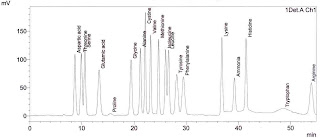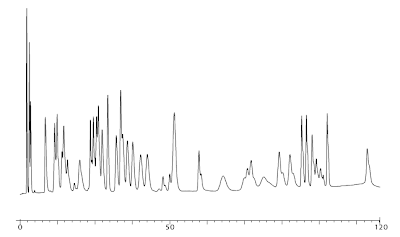Chromatography Quiz #6 Results
We would like to congratulate the grand prize winners of our last newsletter’s Aflatoxins Analysis Chromatography Quiz: Matthew Hartz and Keena Njoroge from Underwriters Laboratories, Steven Moser from the Oklahoma Dept of Agriculture, Food & Forestry, and Holger Franz from Dionex Germany!
They have won, and will shortly be receiving: a gift basket stuffed with Starbucks coffee, tea, and treats! Additionally, for this quiz all of our participants will each be receiving a $20 gift card from Starbucks! Again, we would like to thank you all for your submissions.
The correct answer for the modified Aflatoxins chromatogram: The Aflatoxins G1 and B1 must be derivatized in order to achieve maximum sensitivity. The derivatization is achieved either by reaction with Iodine, or with a photochemical reactor. In this case, we achieved the modified chromatogram by turning off the UVE prior to injection. The same chromatogram would be noticed if the Iodine reagent was not pumping.
Thank you!
Pickering Labs
Chromatography Quiz #7:
Identify the error made when running the Amino Acids chromatogram below and win a prize! Simply email your answer as well as your full contact information to Rebecca at rlsmith@pickeringlabs.com by August 31st in order to win. You will receive email confirmation that your submission has been received. The troubleshooting answer and winner congratulations will be published in the next issue (to be anonymous, please notify Rebecca in submission).
Amino Acid Analysis of Protein Hydrolysate
Pickering Standard: 012506H, 10 μL injected of 0.25 μmole/mL standard in both chromatograms
Pickering Analytical Column: 1154150 High-Efficiency Sodium Cation-Exchange Column (4.0 x 150 mm)
Pickering GARDTM Column Protection System: 1700-3102
Normal Operating Conditions: (for reference only, condition changes may be reflected in chromatogram)
Column Temperature: 48 °C
Flow rate: 0.40 mL/min
Eluent Gradient:
|
TIME
|
1700-0112 %
|
Na740 %
|
RG011 %
|
|
0
|
100
|
0
|
0
|
|
12
|
100
|
0
|
0
|
|
34
|
0
|
100
|
0
|
|
53
|
0
|
100
|
0
|
|
53.1
|
0
|
0
|
100
|
|
55
|
0
|
0
|
100
|
|
55.1
|
100
|
0
|
0
|
|
67
|
100
|
0
|
0
|
Post-column conditions for amino acid analysis:
Reagent 1: Trione
Reactor 1: 130 °C, 0.5 mL
Reagent flow rate: 0.3 mL/min
Detection: UV-Vis Detector, 570 nm for primary amino acids, 440 nm for secondary amino acids
Amino Acids Chromatogram to Troubleshoot:
Amino Acids Reference Chromatogram:
 They have won, and will shortly be receiving: Wine Hourglasses courtesy of Uncommongoods.com! Additionally, all participants will be receiving a $20 gift card from Jamba Juice! Again, we would like to thank all of you for your submissions.
They have won, and will shortly be receiving: Wine Hourglasses courtesy of Uncommongoods.com! Additionally, all participants will be receiving a $20 gift card from Jamba Juice! Again, we would like to thank all of you for your submissions. 












